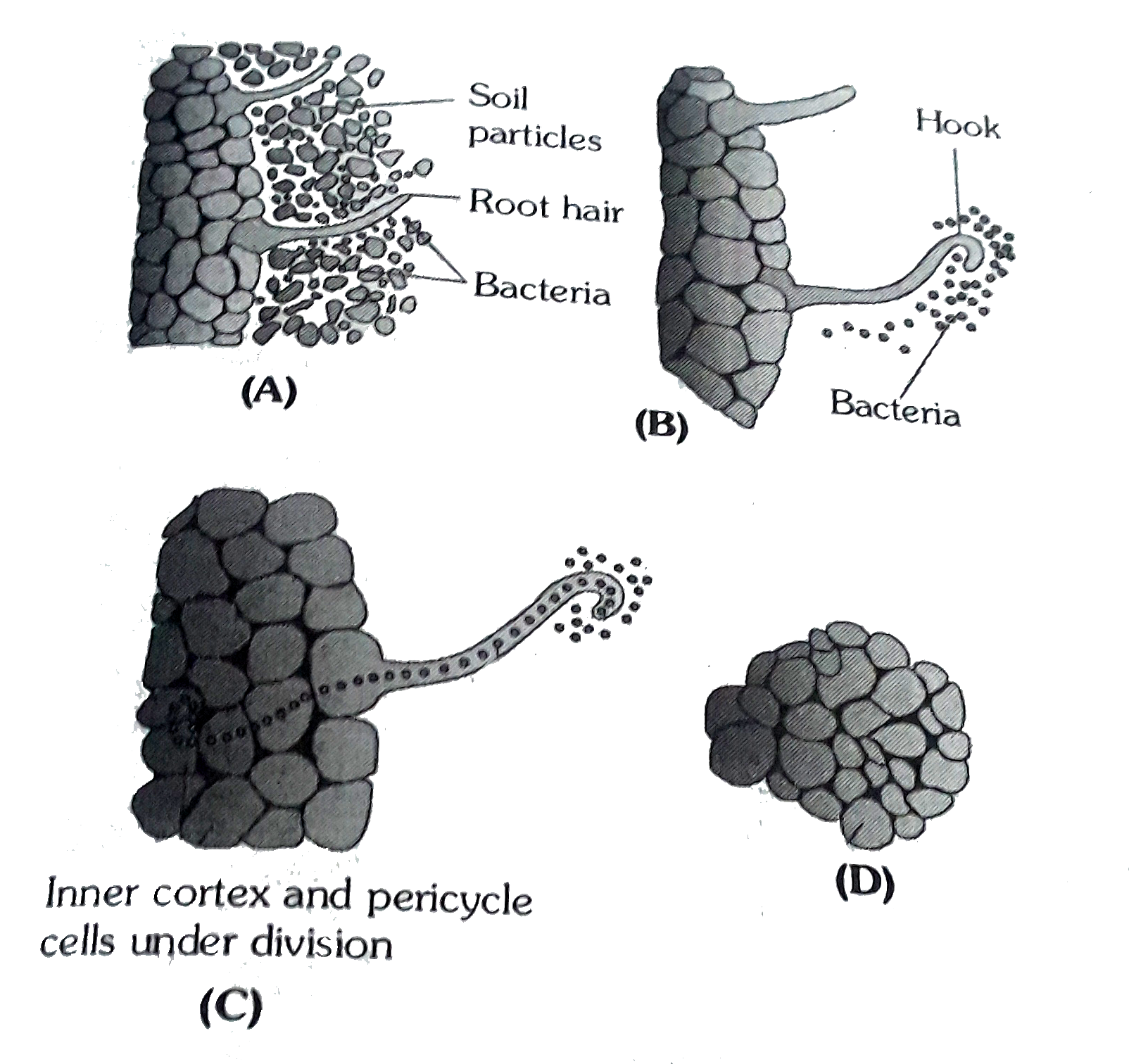[A]: Rhizobial aggregates have been ob- served at distinct sites on curled root hairs.
[R]: The infection thread is formed by a pro- cess of invagination of the hair cell walls in the region of curling
If both A and R are true and R is the correct explanation of A
If both A and R are true but R is not the correct explanation of A
If A is true and R is false
If both A and R are false
The correct Answer is:A
Step by step video, text & image solution for [A]: Rhizobial aggregates have been ob- served at distinct sites on curled root hairs. [R]: The infection thread is formed by a pro- cess of invagination of the hair cell walls in the region of curling by Biology experts to help you in doubts & scoring excellent marks in Class 12 exams.
Topper's Solved these Questions
Similar Questions
Study the given figure which shows the development of root nodules in soyabean. Match the correct explanation and find the correct sequence for labelled diagrams.

(I) Rhizobium bacteria contacting a susceptible root hair.
(II) A mature nodule having vascular connection with roots.
(III). Infection thread carrying bacteria to the inner cortex.
(IV). Curling of root hair due to successful infection.View SolutionConsider the following steps involved in nodule formation in the root of a legume.
(i). Bacteria release chemicals and enzymes.
(ii). Bacteria stop dividing and form bacteroides.
(iii). Roots secrete chemical atractants.
(iv). Formation of infection thread.
(v). Formation of nodules.
(v). Formation of nodulues.
(vi). Division of infected cortical cells.
(vii) Curlinig of root hair and degradation of their cell wall.
(viii). Infection thread grows along with multiplication of bacteria.
Arrange the steps in the right sequence and mark the correct optionView Solution
Knowledge Check
- Question 1 - Select One
The different steps in a nodule formation are given below
I. A matured nodule establishes a direct vascular connection
II. Root hair curls and the bacteria invade the root hair with the host for exchange of nutrients
III. Rhizobium bacteria contact a susceptile root hair, divide near it
IV. The infection thread is produced carring the bacteria and grows into the cortex of the root
V. The bacteria get modified into rod-shaped bacteroids and cause inner cortical layer and pericycle to divide to form nodule.
The correct sequence is -AIII, II, IV, I, V.BIII, II, IV, V, ICIV, V, III, II, IDI, III, V, II, IV - Question 2 - Select One
Choose the correct sequence of step w.r.t nodule formation in legumes.
(a) Root nodule formation
(b) Infection thread formation
(c ) Curling of root hair
(d) Division of cortical cellsAc,d,b,aBc,b,d,aCc,b,a,dDb,c,a,d - Question 3 - Select One
Sequential stage for nodule formation are
I. Rhizobia multiply and colonize the surrounding roots.
II. Rhizobia get attached to epidermal and root hair cells.
III. Root hair curl and bacteria invade root hair.
IV. Initiation of nodule formation in cortex.
V. Infection thread is produced carrying bacteria to cortex.
VI. Bacteria released from thread into cells and cause their differentiation in specialized nitrogen fixing cells.
VII. Nodule formed establishes a direct vascular connection with the host for exchange of nutrient.AI→VII→II→VI→II→V→IVBII→III→IV→I→VII→V→VICVII→VI→IV→I→III→V→IIDI→II→III→V→IV→VI→VII
Select the correct statements
(A) From the region of elongation, some of the epidermal cell for root hairs
(B) Pneumatophores are seen in Rhizophora
(C) Adventitous roots are seen in the Banyan tree
(D) Maize and sugarcane have prop rootsView SolutionSelect the combination of option that will correctly complete the below statements.
I. A typical eukaryotic cell has membrane bound distinct structures namely,(P).
II. All the prokaryotes are known to have a layer of cell wall around its cell membrane except (Q)
III. A special membranous structure found in a bacteria is (R) which is formed by the extensions of the plasma membrane of the cell.
IV. (S) are thin filamentous extensions from cell wall that helps the bacterial cell with motility.View SolutionSelect the correct statements
(A) From the region of elongation, some of the epidermal cell for root hairs
(B) Pneumatophores are seen in Rhizophora
(C) Adventitous roots are seen in the Banyan tree
(D) Maize and sugarcane have prop rootsView SolutionRead the following statement with 1-2 blanks in each one of them:
(i). In monocot root, a large number of vascular bundles are arranged in the form of a ______around the central _______.
Due to the presence of ______,the endodermal substances between cortex and pricycle, in primary dicot root.
(iii). The epidermis of stem of sunflower bears several unbranched _____hair.
(iv). The central portion of a dicot stem is usually occupied by_____comprising of thin-walled parenchymatous cells.
Select the option that correctly fills the blanks in any two of themView Solution

